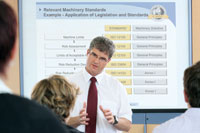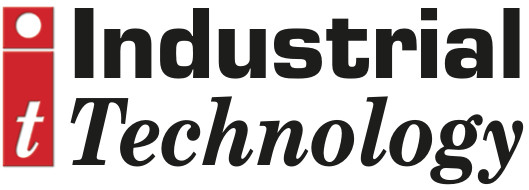
Posted to News on 29th Jan 2013, 00:00
Machinery Safety - A 360 degree approach
The emphasis on safety in manufacturing is continually increasing, as is the complexity of standards and directives. Different safety certification courses have emerged recently, however many only concentrate on a few particular aspects and not the whole picture. Achieving CMSE - Certified Machinery Safety Expert (TÜV Nord) - is, according to David Collier of Pilz, the optimum way to demonstrate your competence in the whole machinery safety life-cycle, and perhaps for your next career step.

>There are several European Directives that can apply to the safety of industrial machinery and equipment (e.g. LVD, EMC, ATEX) but the two of most direct relevance are The Machinery Directive (2006/42/EC and The Use of Work Equipment Directive (2009/104/EC).
>The Machinery Directive essentially states that it is the responsibility of the manufacturer or his authorised representative to ensure that equipment supplied is in conformity with the Directive. The "manufacturer" includes OEMs, but also end users who build, significantly modify or integrate machines together. This Directive is enforced in the UK through "Supply of Machinery (Safety) Regulations".
>The Use of Work Equipment Directive (2009/104/EC) is aimed at machine end-users, to ensure employers take the necessary measures to ensure the safety, health and welfare of their employees. This must be achieved through the use of safe systems of work to ensure a safe working environment and with Risk assessment of machinery and proper validation and maintenance activities. In the UK it is implemented as "The Provision and Use of Work Equipment Regulations" often abbreviated to PUWER.
>The requirements of the Regulations are mandatory under UK Law (they are more or less word for word the same as the Directives), and a presumption of conformity with them can be met through the use of standards harmonised to these Directives. There are many standards, and they change over time; finding your way through them can be challenging.
>Accidents are still happening
>Despite the increasing amount of legislation and the global harmonisation of standards in machinery safety, a noticeable percentage of fatal and non fatal accidents are still occurring each year. More often than not, incident investigations discover several safety issues with equipment involved in the accidents. These safety issues originate in all phases of the life-cycle: specification, design, manufacture, use, modification, maintenance etc. It is becoming more and more apparent that legislation by itself is not enough; engineers need to have the competence and understanding to act in accordance with directives and standards.
>Seldom are health and safety topics included in mechanical or electrical engineering courses. Engineers often learn safety by experience only. Many organisations demand additional education and certification of employees as the preferred way of reducing safety issues on sites.
>Competence is a requirement
>Collins Dictionary defines 'competent' as:
>
Adjective>having sufficient skill, knowledge, etc; capable
>suitable or sufficient for the purpose _ a competent answer
>(law) (of a witness) having legal capacity; qualified to testify, etc
>
>The 2006/42 EC Machinery and 2009/104 EC Use of Work Equipment directives state that validation tests should be carried out with the highest degree of professional integrity and technical competence. Competence is a requirement of every engineer that is assessing a plant, machine or providing a service.
>By way of training and/or experience, a competent person is knowledgeable of applicable standards, is capable of identifying workplace hazards relating to the specific operation, and has the authority to correct them. Competence includes a awareness of one's limitations.
>Employees with responsibility for machinery safety - often multi-tasking - are increasingly expected not only to have but also to prove competence. It is also a proven fact that correctly specified safety measures could actually lead to greater productivity. Employees who feel safe are more productive. This makes safety a critical factor for success. Companies with a consistent safety philosophy are proven to have more market success. A consistent safety philosophy includes not only provision of safe machines, but training to key employees with responsibility for worker safety and for safe control systems. These may be engineering managers, supervisors, design engineers, health and safety officers, risk managers, and anyone with input into machine design, operation and maintenance.
>The high costs of not addressing machinery safety are well documented, not only the 'up front' cost of accidents - insurance costs covering injury, ill health, damage - which account for roughly 10% of costs; the other 90% of costs are 'hidden' such as product and material damage, plant, machinery and building damage, legal costs, emergency supplies, site cleaning, production delays, temporary labour, fines and loss of expertise.
>Implementing a good machinery safety concept can not only minimise the risk of accidents. It will offer a level of safety that conforms to relevant standards and legislation without being over-engineered and prohibitively expensive. A poor safety concept may not only fail to conform, it may actively hinder the machine operators, leading them to seek ways to overcome the safety measures. It can make machine maintenance more difficult and time consuming, impact on availability through a high number of false trips and can be difficult to diagnose and maintain.
>The person developing the overall safety concept needs to have an in-depth knowledge of the relevant legislation, regulations and standards, as well as the appropriate safety technologies. Fit-for-purpose machinery safety training courses can provide a valuable supplement to practical machinery-based experience, which itself is something that is only attainable over time and under the right circumstances.
>Benefits for employees and employers
>Although competence is a legal requirement for an engineer who is tasked with validating plant and machinery, this should not be the only reason to become certified. Some employees might say that they don't need certification; that they have been working for years doing risk assessments or designs to mitigate risks, they have seen 'everything' and will get no advantage from a certification. They are many advantages in getting certified such as proving your knowledge; increasing your value as a company asset; taking your career to the next level; keeping up to date.
>Employers gain from investing in their employee's competence too. They gain the assurance that plant, machinery or services comply with legislation; there can be a reduction in outsourcing of safety work; productivity gains can be realised through better implemented safety; higher staff morale.
>Safety is based on more than just control systems and functional safety
>Some companies offering training which takes the approach that all hazards need to be covered by safety functions and safety devices using IEC 62061 and ISO 13849-1, and given the advancement of safety devices over recent years it is often possible to do so. The reason for this approach could be that the graph in Annex A.1 of EN ISO 13849-1 is often viewed as a risk graph resulting from a risk assessment. In actual fact the output of this "risk graph" is not a measure of risk; but a determination of a required performance level (PL a-e) for a particular safety function.
>This approach however does not follow best practice as outlined in EN ISO 12100. Functional safety should only be considered when a risk assessment has been completed, all risk elimination measures have been considered and protective measures, which include the use of fixed and moveable guards, are to be implemented. The so-called "Three step approach" as outlined in EN ISO 12100 requires that elimination or substitution of the hazard must be investigated first and only where this is not possible should engineering measures such as safety measures be considered. The hierarchy of risk reduction is:
>
- Change Design - eliminate hazard
- Protective measures - safeguarding (including functional safety)
- Warning - information for use
>Once the decision to implement safeguards has been taken there are a number of standards to be taken in to consideration. It is only once the decision to use control functions (for example interlocking of guards, light curtains, etc) as part of the hazard mitigation strategy has been taken that the functional safety requirements are specified, verified and validated using EN ISO 13849-1 or EN 62061. Functional safety needs to address all technologies be it electrical, hydraulic or pneumatic and cover all safety aspects from sensing devices, control circuit to the machine actuators. In order to achieve machine safety in the most suitable and cost effective way knowledge of all applicable machine safety legislation and standards, risk assessment, risk mitigation strategies, machine guarding, functional safety and administrative measures is required.
>Drawing on extensive experience and knowledge in the area of machinery safety, CMSE (Certified Machinery Safety Expert) has been specifically developed by Pilz to provide the market with an expert level training in the area of machinery safety, providing a 360° all-encompassing approach, to enable those who complete the training to prove their competence through an independent certification by TÜV NORD.
>The course is primarily aimed at design engineers, project engineers, safety engineers and development engineers from the field of automation technology as well as maintenance engineers and industrial engineers. Divided into 5 modules, topics include:
>
Module 1: Fundamentals of safety, introduction to legislation and standards, motivation for safety, responsibilities of duty holdersAt the end of the training, participant understanding of the five modules is verified through a multiple choice examination. Due to the stringent 80% pass rate required to achieve the certification, an in-depth knowledge and understanding of the course content is required. Based on the test results, successful participants will be awarded a TÜV NORD certificate which is valid globally, and can use the letters CMSE after their name. Recertification is necessary every four years to maintain the title CMSE. For further information, and application details, please visit www.cmse.com or email [email protected].>Module 2: Machinery safety legislation, conformity procedures, equipment and workplace regulations, occupational health and safety
>Module 3: Risk assessment and practical risk assessment workshop
>Module 4: Mechanical guarding, safety components / technology, electrical safety
>Module 5: Functional safety of control systems, functional safety of pressurised fluid systems (hydraulic and pneumatic), functional safety workshop with worked examples
>







